Projects
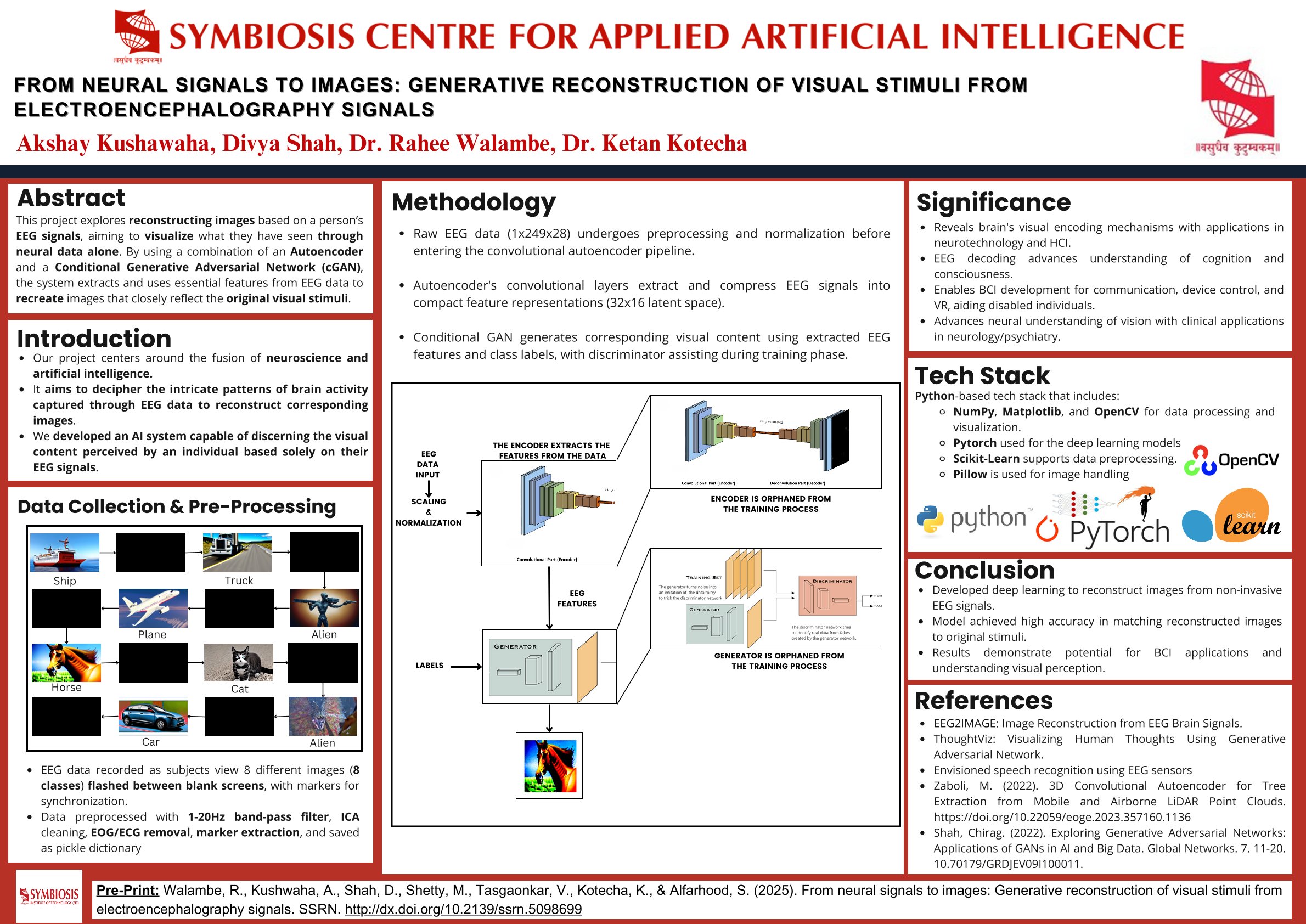
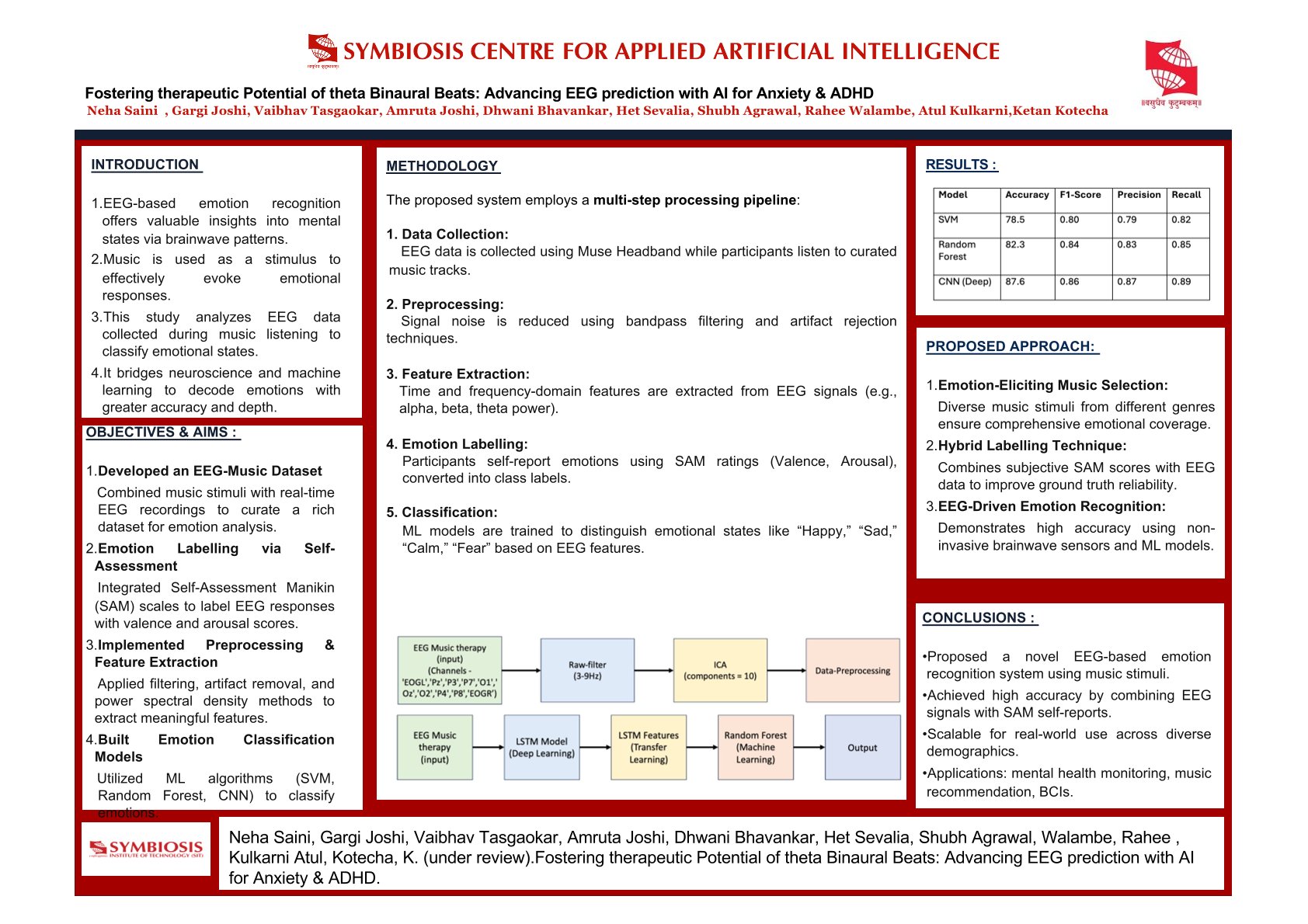
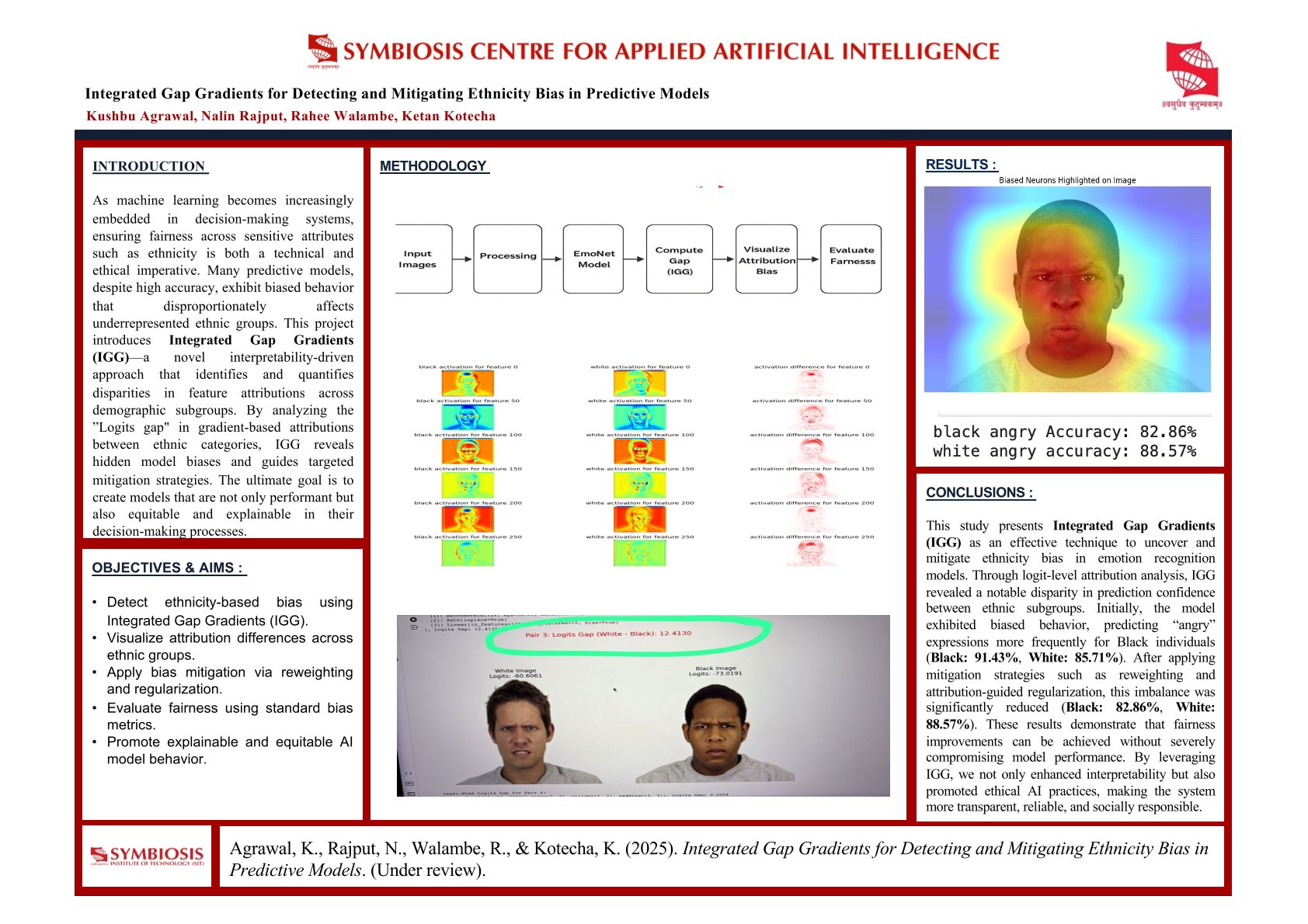

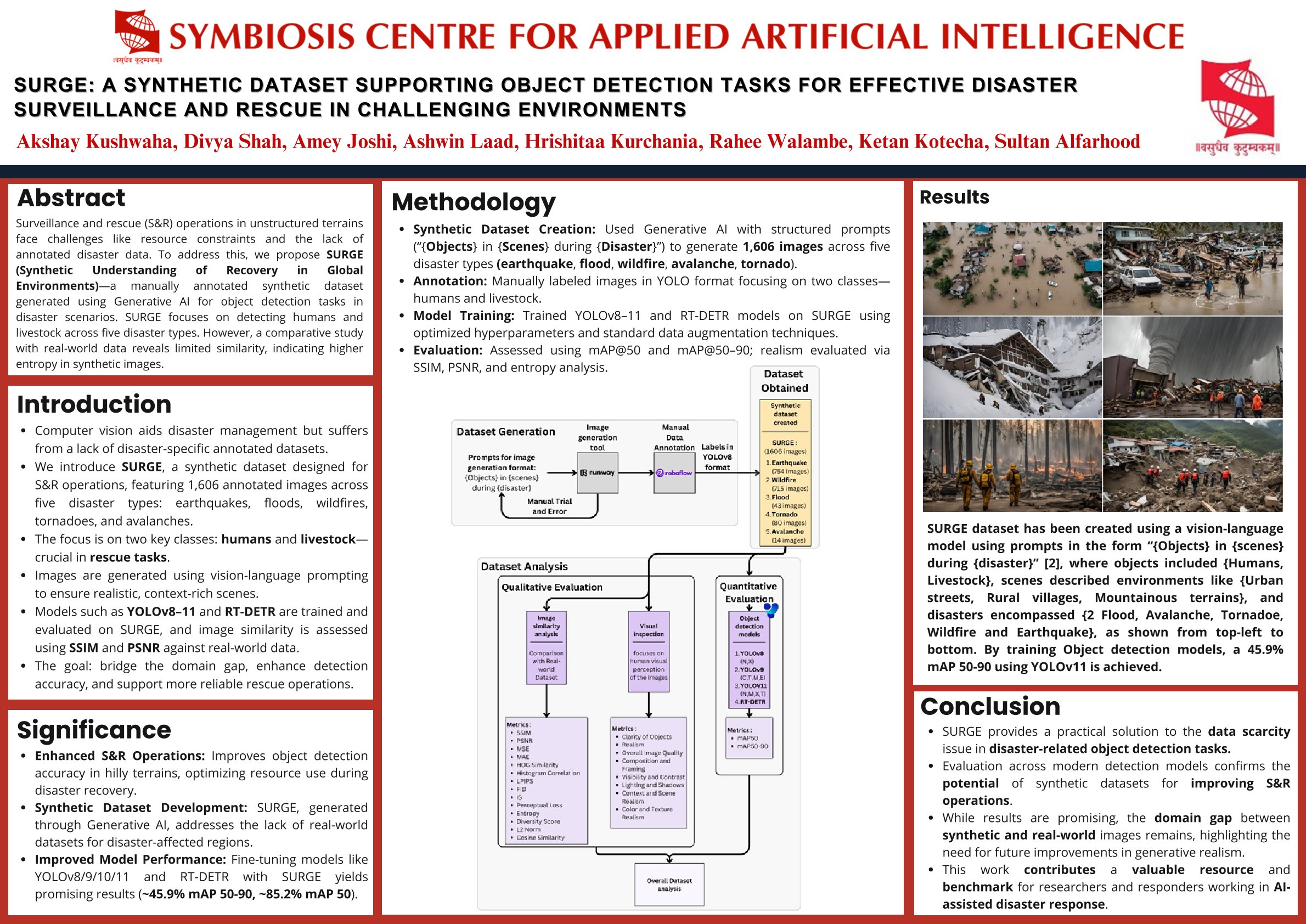

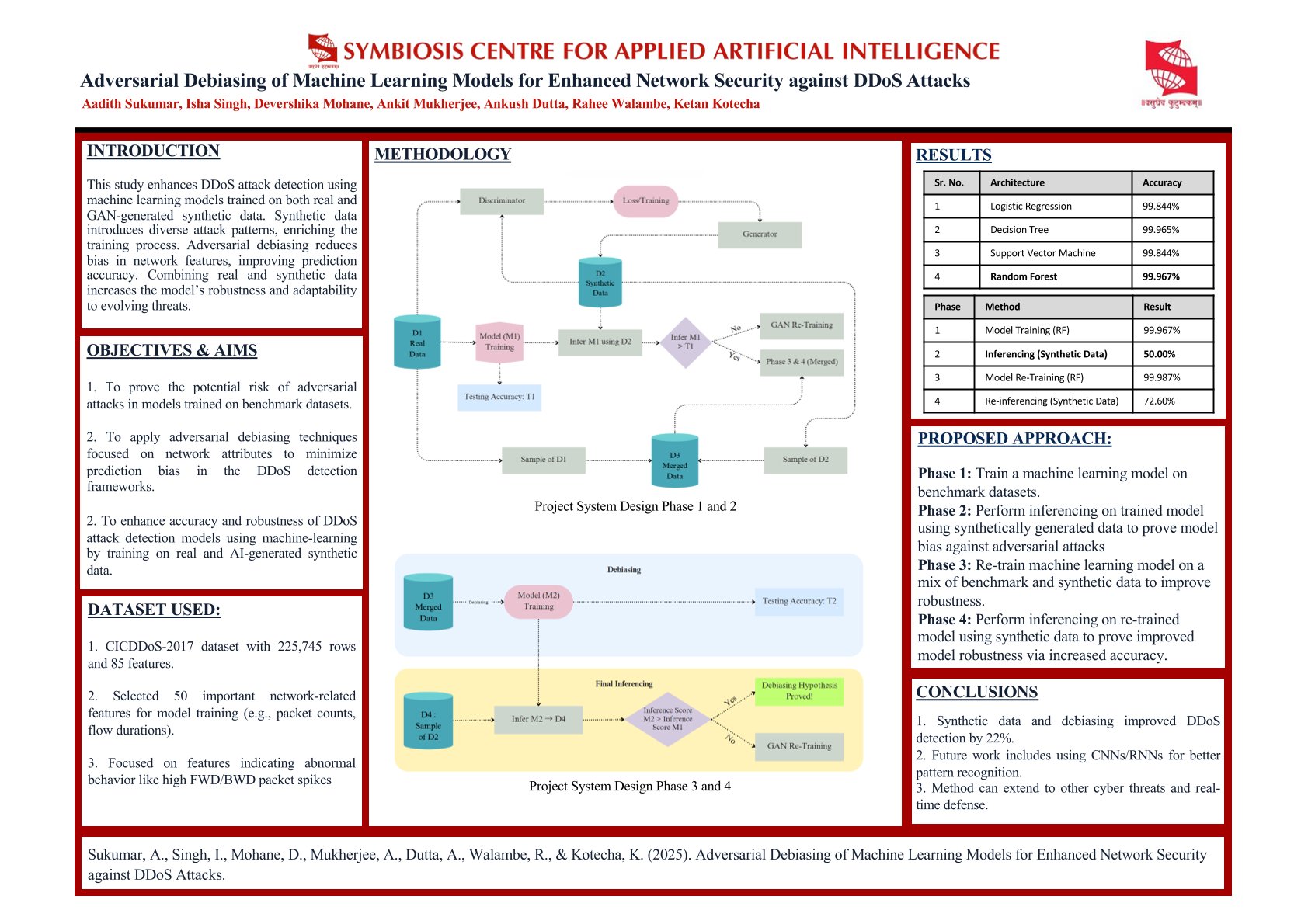
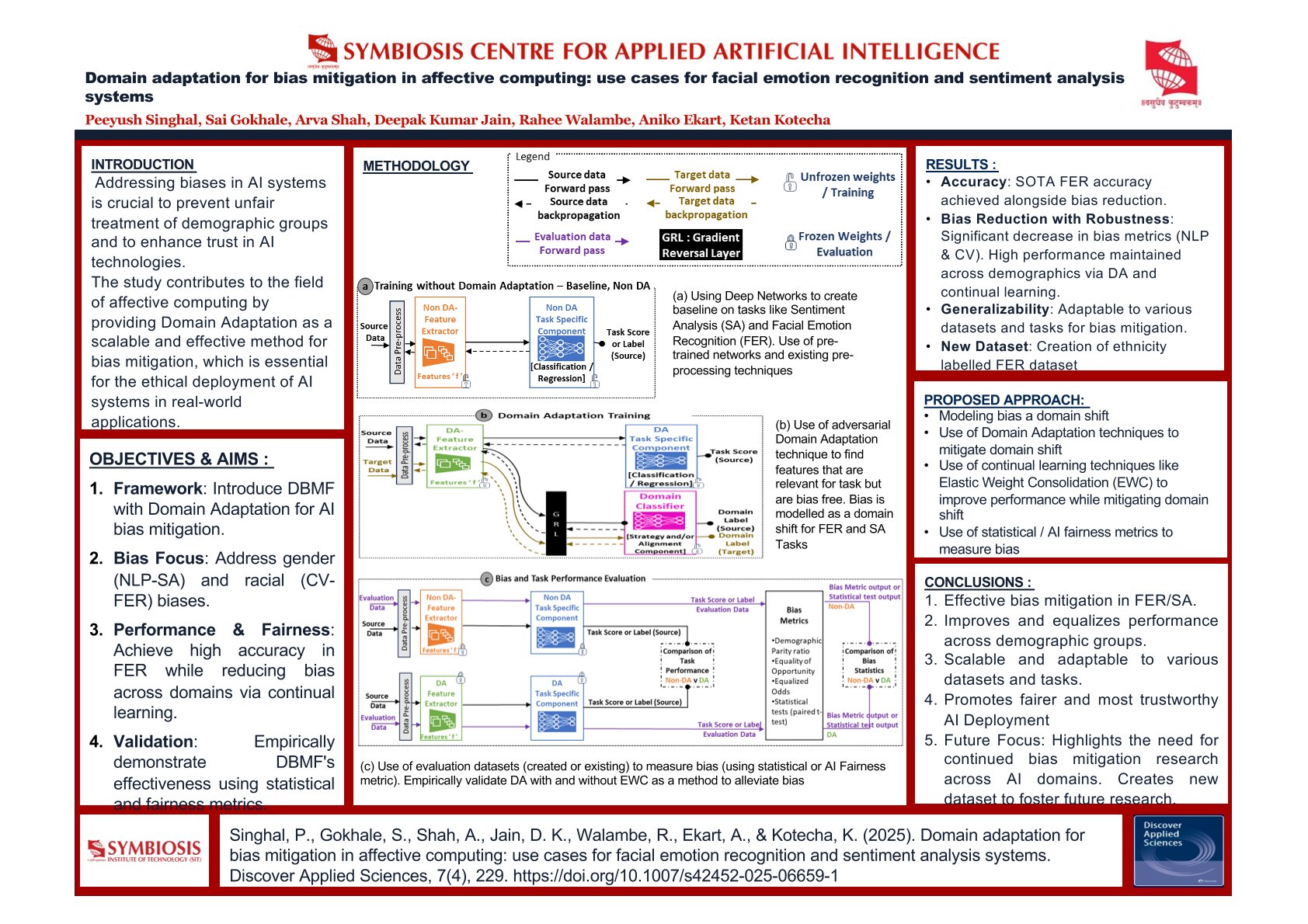
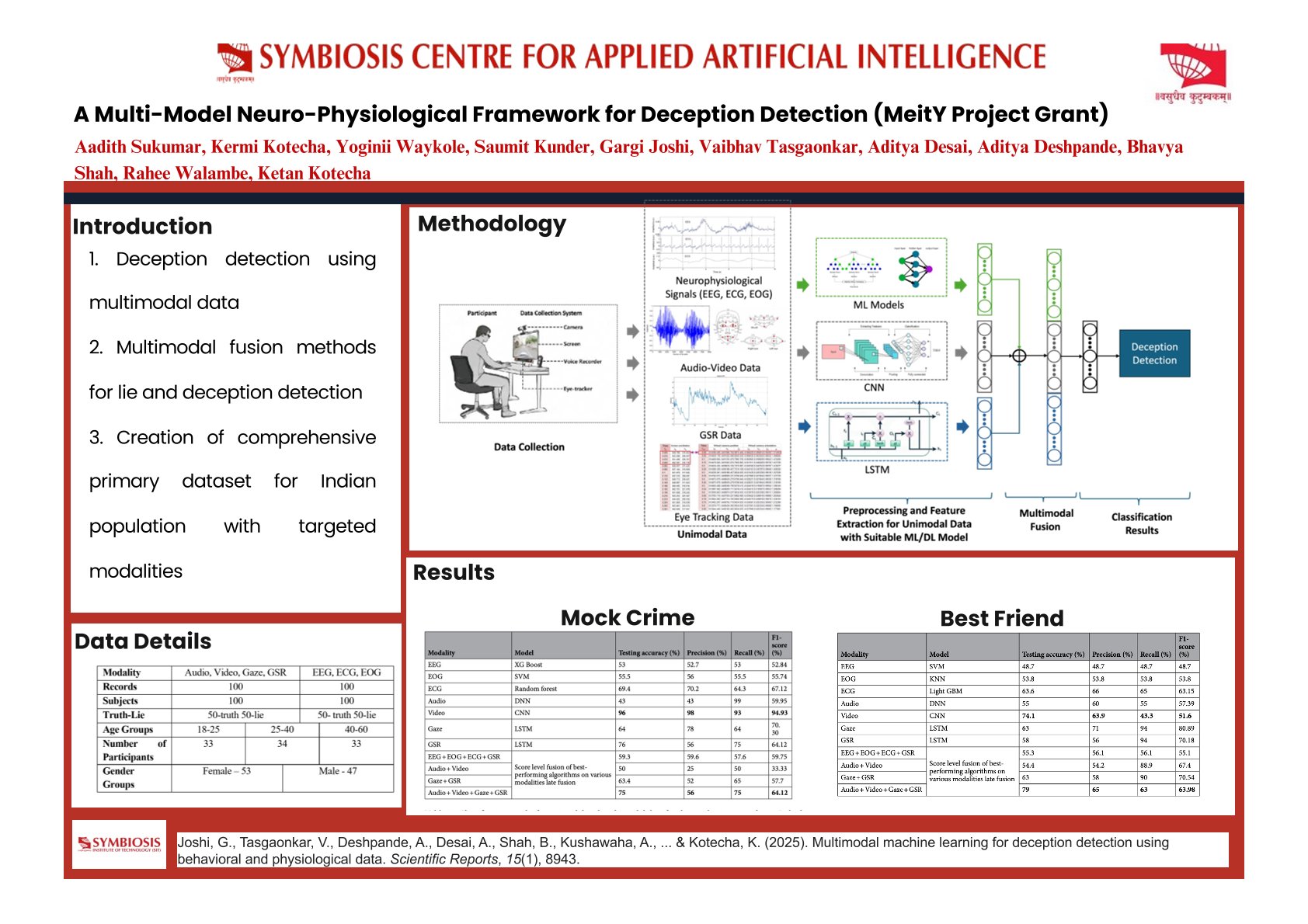
_00001.jpg)
_00004.jpg)
_00006.jpg)
_00008.jpg)
_00009.jpg)
_00002.jpg)
_00003.jpg)
_00005.jpg)
_00007.jpg)
_00010.jpg)
_00011.jpg)
_00012.jpg)
Project ID 01:
Project Title: Explainable AI and Multimodal deep learning for Healthcare Data
Student Members:
Pranav Nayak, Final Year IT
Ashmit Bharadwaj, Final Year IT
Mentor Name:
Dr Rahee Walambe Associate Faculty ,SCAAI
Associate Professor, Dept of E&TC , SIT
Objectives and Methodology
In the 21st Century we are moving towards information age, where more and more sedentary jobs are getting created. In this fast paced life mental health is of the utmost importance. Mental health issues can both directly and indirectly affect other parts of the body and capable of hampering your day to day activities and your performance. We therefore aim to help people working sedentary jobs to monitor their working behaviour and stress levels. This will help users understand their own body and then they and take necessary steps to improve their health and performance.
Our methodology here is to develop AI based multimodal fusion techniques for handling multimodal data so that it can be used efficiently for training AI models. Multimodal fusion enables users to interact with computers through various input modalities like speech, gesture, and eye gaze. Though combining different modalities or types of information for improving performance seems intuitively appealing task, but in practice, it is challenging to combine the varying level of noise and conflicts between modalities. Moreover, modalities have different quantitative influence over the prediction output. To generate human interpretable explanations for these AI models using Explainable AI methods. To store these explanations securely in a blockchain so that the user can access these anytime with full anonymity.


Project ID 02:
Project Title: To Build up a AI based Smart Entry Log System for storing data obtained from live Camera Recording.
Student Members:
Anusha Gadgil, Final Year BTech (E&TC)
Arjun Thakur, Final Year BTech (E&TC)
Mihir Gohad, Third Year BTech (MECH)
Mentor Name:
Dr. Rahee Walambe,
Associate Faculty, SCAAI and Associate Professor, Dept of E&TC, SIT
Objectives and Methodology
The ultimate aim of our project is to ease the process of logging details of vehicles entering our campus in real time. We plan to achieve this using Deep Learning Algorithms like CNN and SSD. First, we detect the License plate then recognize it, then we check for 2 wheeler, person and helmet. If it’s a 2 wheeler, all of this data is stored in excel sheet.
Video processing will be done using camera feed to look for vehicles. We have used our XML classifier with OpenCV functions for detecting License plates from the video. Each time the Plate is detected in the video, it is saved as a cropped image to a desirable location where OCR is applied on it. The OCR will recognise licence plate and stored. Once we get new cropped image, the old one gets deleted automatically. We made sure that the plate is detected only once. Therefore, we stored this License plate in text format along with the Timestamp. We have tested around 150 images on OCR and got an accuracy of 90%. Furthermore, we tested License plate and helmet detection algorithms on around 30 videos and got 80 % accuracy and collected 1,000 images for training Helmet detection model & then saved the model. Lastly, we used SSD model for detecting person, two-wheeler with our saved CNN model for detecting presence or absence of Helmet and then stored the data in Excel Sheet.

Project ID 03:
Project Title: Development of Techniques for Generating Photo Realistic Images from Textual Description
Student Members:
Sharad Pande
Ritesh Sonavane
Srishti Chouhan
Final Year BTech (EnTC)
Mentor Name:
Objectives and Methodology
Converting from text-to-image is a fundamental and novel domain of research in computer vision. It could be seen as a reverse task to image caption, aiming to generate photo-realistic images from input textual description sentences. Text-to-image synthesis helps to find the relationship between text and image, traversing the visual interpretation mechanism of the human brain. Besides, it also has numerous application potentials like computer-aided design, art creation, face generation, image searching. Our main goal is to be able to generate faces from its textual description, and we intend to translate text which is in the form of human-written single-sentence descriptions directly into images. We used Stack GAN, PG GAN and AttnGan to achieve this conversion.
StackGAN: This GAN is typically used for synthesizing images from textual description. It breaks down the text-to-image generation process into two stages, Stage-I and Stage-II.




Project ID 04:
Project Title: Detecting onset of alzheimers using CNN
Student Members:
Varun Jain (ENTC) - 17070123045
Daryl Jacob Jerrish (CS) - 18070122017
Om Nankar (IT) - 19070124045
Mentor Name:
Dr. Shilpa Gite
Objectives and Methodology
The objective of this project is to find patterns in MRI images of the patients brains’ to detect onset of alzheimers. Our approach towards the project was using the Convolutional Neural Networks as the dataset contains images. The methodology can be broken down to 4 stages:
Dataset acquisition and processing:
The dataset we took into consideration had to be augmented (data augmentation techniques such as flipping the image, rotating the image) in order to better our findings.
Training the model using CNN:
The data was divided into 4 categories:
Non-demented
Very mild demented
Mild demented
Moderate demented
Usage of feature learning through application of strided convolutions and pooling layers in the model, feature selection and extraction.
Optimization:
Improving accuracy and betterment of results using ADAM optimizer and adding categorical cross entropy for loss computation.
Training and Deployment.

Project ID 05:
Project Title:- Automated Coronary Artery Disease(CAD) diagnosis using ECG signal and convolution neural network
Student Members:- Abhinav Mishra second year(CS)
Mentor Names:- Dr Shilpa gite, Hariharan Venugopal
Objectives and methodology:
The primary objective of the project is to distinguish between cad and non-cad patients using ECG signal of their heart using a custom convolution neural network.
To perform cad classification on ECG signal, first, we denoise using wavelet transform, median filter, and low pass Butterworth filter because raw ecg may contain noise like baseline wander, power line interference, motion artifact etc after denoising ECG segmentation was done to increase the dataset and reduce the effect of the noise and then normalization technique is implemented to normalize the individual ecg segment this is to overcome the problem of amplitude scaling and to remove the offset effect .Custom cnn was used to learn the features from input data and a classifier was used to perform classification.



Project ID 06:
Project Title- Emotion Detection from Audio and Video
Student Members
Chirag Dalvi – Final Year BTech (CS)
Manish Rathod – Final Year (IT)
Arihant Surana – Third Year BTech (CS)
Mentors: Dr.Shilpa Gite & Dr. Shruti Patil
Objectives and Methodology
In times of current pandemic, we have been forced to adopt new digital lifestyles including Online Teaching. Most schools and Universities have shifted their teaching from Offline to Online mode. Though the Study material and the syllabus remain the same but handling an online teaching is still a difficult task as compared to conventional physical classes. This project aims to develop an automated AI tool to create for teachers to understand the emotional state of kids during online school learning to create activities or study methods to bring up their learning moods. To analyse the Emotions from both audio and video, we have divided the project into four categories: DataSet Selection, Visual Facial Emotion Recognition Model and Audio Emotion Recognition Model, Fusion of Predicted data from both Video and Audio Model, respectively. We aim to generate a robust dataset of audio and video clips for implementation. After individual predictions, we will fuse the results and build a software that can detect and classify the emotional state of the end user in real time.

Video

Audio

Project ID 07:
Project Title: Yoga Pose Estimation
Student Members:
- Jenet R Scaria, Final Year BTech(E&TC)
- Arihant Surana, Third Year Btech(CS)
- Drishti Singh, Third Year BTech(CS)
Mentor: Dr. Shilpa Gite, Assistant Professor, CS Department, SIT
Objective/Methodology:
With the recent advancements in Artificial Intelligence, computers can now leverage many human-like abilities in their operations using image processing and computer vision technology. One such application is Human Pose Estimation. The poses are distinguished from each other at the joints of body parts. An application of pose estimation which has attracted many researchers is exercise and one of its form with intricate postures is Yoga which is an age-old now famous worldwide because of its many spiritual, physical and mental benefits.
Pose estimation for fitness applications is particularly challenging due to the wide variety of possible poses (e.g., hundreds of yoga asanas), numerous degrees of freedom, and occlusions. The approach used here is the skeleton-based model where a set of joints (keypoints) like ankles, knees, shoulders and limb orientations of a human body are detected from an image or a video frame, which are then utilized to create a skeletal structure of the posture at any instant of time.
The RCNN model has shown the most significant results in Pose estimation problems. The input image goes through the CNN. The feature maps generated are used for the region proposal network (RPN) to generate region proposals, and used for generate feature maps for RoIAlign pooling at later part. The whole network is an end-to-end deep learning network, which is essential for gradient propagation to improve the pose detection accuracy.

Project ID 01:
Project Title: A Study on the Integration of Explainable AI and Blockchain and its Application in Credit Scoring
Student Members:
Ashwin Kolhatkar, Final Year BTech (CS)
Manas Ojha, Final Year BTech (CS)
Akash Kademani, Final Year BTech (CS)
Sakshi Kathote, Final Year BTech (CS)
Mihir Pandya, Final Year BTech (CS)
Objectives and Methodology
Credit scores are an important factor that financial institutions consider when deciding whether to approve a loan or not. The scores are designed to predict the likelihood of repayment of a loan. Many of the current ML/AI algorithms just provide the result on whether a particular customer will default on loan repayment or not. An explanation as to why the loan was denied is usually not available. The major issue with complex machine learning models is that they lack interpretability. Our project aims at integration of the Explainable AI (XAI) with the blockchain technology and determining whether a certain user has a good credit score or not, supplemented with an explanation for the same. In this project a system to generate explanations along with the predictions for every single user and making it securely accessible to everyone is designed. Managing the transparency, security and tracking of decisions made by the model over some time for a user is accomplished by constructing a blockchain.

Project ID 02:
Project Title : Generation of Deep Fakes Detection using GANS for textual articles.
Student Members:
Prince Chaudhary, Final Year BTech (IT)
Avani Bajaj, Final Year BTech (IT)
Ajayveer Singh, Final Year BTech (IT)
Vidhi Jain, Final Year BTech (CS)
Objectives and Methodology:
The objective was to create a network that could automatically generate full-length articles and as the fake news publishers have become more sophisticated in their propagation strategies, these machine learning models have been introduced to rapidly detect patterns in news sources and articles. The main task was to provide a classifier that would differentiate between the generated fake text and real text which would help in financial fraud and fake news article detection.

The technology used is Generative Adversarial Networks (GANs). One network, called the generator, generates new data instances, while the other, the discriminator, evaluates them for authenticity; i.e. the discriminator decides whether each instance of data that it reviews belongs to the actual training dataset or not. Basically we have tried to mislead discriminator using two neural networks, pitting one against the other in order to generate new, synthetic instances of data that can pass for real data.

Project ID 03:
Project Title : Segmentation of Blood Vessels from Retinal Fundus Images
Student Members :
Akash Dholaria, Final Year BTech (CS)
Gauri Nigam, Final Year BTech (CS)
Shambhavi Shikha Tiwari, Final Year BTech (IT)
Rajat Pandey, Final Year BTech (IT)
Objective and Methodology
The primary objective of this project is image segmentation of Retinal Fundus image in order to obtain a pattern of blood vessels, that can be used to classify disease within a retinal image.
To perform segmentation on the biomedical images, we used semantic segmentation because it is a technique that detects, for each pixel, the object category it belongs to, all labels must be known to the model. In our case, for segmenting an image and classifying it, the input image is a retinal fundus image with the first-hand task of lining and segmenting out the blood vessels pixel by pixel. The architecture used is the U-Net architecture where each pixel is classified to be the part of a vessel or not by predicting a probability and comparing it with a chosen threshold.

Framework of the Methodology

UNet Framework

Input Image

Ground Truth

Predicted Image
Project ID 04:
Project Title: Evaluation of Adversarial training Methods on image based machine learning setups
Students Members:
Vidit Chokshi, Final Year BTech (CS)
Manthansingh Bisht, Final Year BTech (CS)
Vineeth Nair, Final Year BTech (CS)
Abheek Ranjan Das, Final Year BTech (IT)
Security is a mandatory feature in the field of computer vision. Adversarial attacks are one of the most famous techniques used for breaching security, which attempts to fool AI models by malicious input. For our project, we took the case of chest x-rays, since medical data is extremely fragile and minute tampering can lead to unforeseen and disastrous effects. Especially with the increase of data breaches involving medical data, it has become essential to add new types of security measures to make the models robust. In this project, initially, various types of adversarial attacking strategies are used to introduce noise into the images in the input dataset. These modified images are generally indistinguishable to the human eye, but can easily mislead the model into a completely wrong prediction. The goal is to deceive an already trained model. The defensive strategies help to make the model robust by identifying the attacks and avoid misleading predictions by the model. We implemented three different types of defense strategies against poisoning attacks to check the robustness improvement in the model.

Figure 1: Adversarial machine learning project pipeline
Project ID 05:
Project Title: Evaluation of Adversarial training Methods on image based machine learning setups
Students Members:
Vidit Chokshi, Final Year BTech (CS)
Manthansingh Bisht, Final Year BTech (CS)
Vineeth Nair, Final Year BTech (CS)
Abheek Ranjan Das, Final Year BTech (IT)
Security is a mandatory feature in the field of computer vision. Adversarial attacks are one of the most famous techniques used for breaching security, which attempts to fool AI models by malicious input. For our project, we took the case of chest x-rays, since medical data is extremely fragile and minute tampering can lead to unforeseen and disastrous effects. Especially with the increase of data breaches involving medical data, it has become essential to add new types of security measures to make the models robust. In this project, initially, various types of adversarial attacking strategies are used to introduce noise into the images in the input dataset. These modified images are generally indistinguishable to the human eye, but can easily mislead the model into a completely wrong prediction. The goal is to deceive an already trained model. The defensive strategies help to make the model robust by identifying the attacks and avoid misleading predictions by the model. We implemented three different types of defense strategies against poisoning attacks to check the robustness improvement in the model.

Figure 1: Adversarial machine learning project pipeline
INTERNSHIP PROJECT 1:
Project Title: Gas Detection and Identification Using MultiModal AI based Sensor Fusion
Student Members(names with branch details):
Shruti Mandaokar, Final Year BTech (ENTC)
Pulkit Chandel, Final Year BTech (ENTC)
Mentor Name:
Dr Rahee Walambe Associate Faculty ,SCAAI
Associate Professor, Dept of E&TC , SIT
Dr. Ketan Kotecha, Head, SCAAI
Collaborator: Dr. George Ghinea, Brunel University, UK
Objectives and Methodology (with schematic/ flowchart/diagram):
With the rapid developments in the industrialization and automated chemical plants, gas leakage is a common issue. Explosions, fires, spills, leaks, and waste emissions are some of the consequences of industrial accidents. Most of the gases and their fumes are colorless, odorless, and tasteless, thereby challenging our normal human senses. Sensing based on a single sensor may not be accurate, and sensor fusion is essential for robust and reliable detection in several real-world applications. The primary research question was - In a mixed gas environment, how to detect a particular gas and achieve better gas classification accuracy?
In this work, we propose a novel approach to detect and identify the gaseous emissions using the multimodal AI fusion techniques. We manually collected 6400 gas samples (1600 samples per class for four classes) using two specific sensors: the 7-semiconductor gas sensors array, and a thermal camera. The early fusion method of multimodal AI, is applied .The network architecture (CNN+LSTM) consists of a feature extraction module for individual modality, which is then fused using a merged layer followed by a dense layer, which provides a single output for identifying the gas.
Contribution of this work - Develop a more reliable gas detection method involving two modalities and fusing them to achieve better results than existing methods.


DATA COLLECTION :



METHODOLOGY :
Early Fusion -
Combines features extracted from raw data which have high correlation between them, which are passed through Concatenate layer and final predictions are made.

Late Fusion -
Decisions are taken based on the individual modalities separately. Predictions from individual modalities are then combined using statistical methods like mean, mode, median.

Publication: Parag Narkhede, Rahee Walambe, Mandaokar Shruti, Pulkit Chandel, Ketan Kotecha, George Ghinea. Gas Detection and Identification Using Multimodal Artificial Intelligence Based Sensor Fusion. MDPI Applied System Innovation, 2021. https://www.mdpi.com/2571-5577/4/1/3
INTERNSHIP PROJECT 2:
Project Title: International Trade Data Analysis using Machine Learning techniques
Student Members:
- Ananya Srivastava, Final year BTech E&TC
- Zainuddin Saiyed, Final year BTech CS
Mentor Name:
Dr Rahee Walambe, Associate Faculty, SCAAI,
Associate Professor, Dept of E&TC, SIT
Dr. Ketan Kotecha, Head, SCAAI
Collaborator: Dr. Ishita Ghosh, Symbiosis School of Economics, Dr Jyoti Chandiramani, Director, Symbiosis School of Economics
Objectives and Methodology:
The exchange of goods or services between territories is known as International trade. And in many cases International trade plays a very important role in constituting the total Gross Domestic Product (GDP) of that territory. The objective of this project is to forecast the total trade of India’s trading partners in vis-à-vis trade in services. Services are the economic output of intangible commodities that may be produced, transferred, and consumed at the same time. There are many factors that influence the overall trade of a territory. An analysis on these features is required to understand how they relate to each other and the impact of such features on the overall trade of a territory.


INTERNSHIP PROJECT 3:
Project Title: Using ML based methods for predictions of COVID information
Student Members: Mohammed Hasan, CS & IT Department
Yagnik Bhargav, CS & IT Department
Mentor Name: Dr. Rahee Walambe, Associate Faculty, SCAAI,
Associate Professor, Dept of E&TC, SIT.
Dr Ketan Kotecha, Head, SCAAI
Objectives and Methodology:
Predicting and understanding the growth of Coronavirus was very important for the Government to plan and take necessary actions to prevent it. We created a dashboard for predicting various parameters like No. of cases, No. of deaths in India, Maharashtra, and the No. of Males and Females infected. The data was sourced from the Ministry of Health, Govt. of Maharashtra. Numerous statistical forecasting techniques like ARIMA, SARIMA, Prophet etc were implemented for the same dataset to obtain the least Root Mean squared error. The various approaches were tested and a hybrid forecasting models was created which could predict with an accuracy of 0.02% for the no. of cases in India.

INTERNSHIP PROJECT 4:
Project Title: Using AI methods to generate malicious network traffics undetectable by Intrusion Detection Systems
Student Member:
Jugal Shroff, Second Year BTech (CS)
Mentor Name:
Dr. Rahee Walambe
Associate Faculty, SCAAI and Associate Professor, Dept of E&TC, SIT
Dr. Ketan Kotecha, Head, SCAAI
Objective:
Generative adversarial network is a technique employed in the field of Artificial Intelligence which attempts to fool models through malicious inputs. The objective is to generate malicious network traffic instances (like DDoS) looking similar to benign ones using adversarial AI which can bypass the Intrusion Detection System without creating any suspicion.
Methodology:
Generative Adversarial Networks (GANs) architecture is used for this purpose. Initially, the model is trained using a random noise vector and benign network traffic instances. This way, the Generator finally learns how the non-malicious network traffic instances looks like and tries to produce the malicious traffic instances looking similar to the benign ones.
For testing and evaluation purpose, we first measure how different the output generated by the Generator is w.r.t the original benign network traffic instances. Then we pass this Generator output to the classifier (IDS) and see what the classifier’s accuracy is. One of the objectives is to keep this accuracy as low as possible.
- Training

2. Testing

INTERNSHIP PROJECT 5:
Project Title: Email Spam Detection using Domain Adaptation
Student Members:
Avani Mundra, Third Year Btech (CS)
Ria Gohel, Third Year Btech (CS)
Tanvi Pathak, Third Year Btech (IT)
Mentor Name:
Dr. Rahee Walambe
Associate Faculty, SCAAI and Associate Professor, Dept of E&TC, SIT
Objectives and Methodology:
The primary objective of this project is to develop a spam filter which segregates the spam emails from the ham(non-spam) emails using Recurrent Neural Network (RNN) and domain adaptation. Every email account’s inbox today is filled with unwanted emails from various companies including promotional emails, emails from social media websites, emails containing links to unsecure websites etc. which hampers the authenticity and outreach of important emails for the user. This project aims to solve this real world problem by integrating a classic spam classifier with domain adaptation technique to achieve state-of-the-art spam filtering system. To implement this, we used SpamAssassin dataset as our source domain and our own emails dataset as target domain. Data preprocessing and text cleaning was carried out on both the datasets followed by feature extraction to convert the words to floats. We used an embedding layer followed by RNN to create the neural network for predictions. To incorporate domain adaptation, we used Domain Adversarial Neural Networks (DANN) and trained it on the labelled source dataset to achieve high accuracy on the unlabeled target dataset.


INTERNSHIP PROJECT 6:
Project Title: Detection of Hateful Speech for Hinglish Data on Social Media
Student Members:
Ananya Srivastava, Final Year BTech (E&TC)
Bhargav Yagnik, Final Year BTech (CS)
Mohammed Hasan, Final Year BTech (CS)
Mentor:
Dr Rahee Walambe – Associate Faculty, SCAAI, Associate Professor, Dept. of E&TC, SIT
Dr. Ketan Kotecha, Head, SCAAI
Objective / Methodology:
The rise in the usage of social media has led to escalation of contrasting ideologies and hateful speech on social media. Opinions that an individual would earlier desist from due to fear of repercussions from society have now found their way online. With most of the urban population in India being bilingual, the use of Hindi-English code mixed – Hinglish language is quite prevalent across various social media platforms. Hate speech detection algorithms deployed by most social networking platforms are unable to filter out offensive and abusive content posted in these code-mixed languages. This makes it essential to have an efficient hate speech detection algorithm which can be used to deal with such content in Indian social media space.
The objective of this project was to detect hateful speech in Hinglish language. For this, fine tuning based approaches were applied by utilizing contextual based embeddings such as ELMo, FLAIR and transformer-based BERT. The project involved creating an annotated hate speech dataset in Hinglish, building a generic pre-processing pipeline along with development and validation of deep learning based approaches for detection of hate speech in Hinglish text.

Publication : Bhargav Yagnik, Mohamed Hasan, Ananya Shrivastava, Rahee Walambe, Ketan Kotecha. Detection of Hateful Speech for Hinglish Data on Social Media. In Lecture Notes in Electrical Engineering series, Springer , accepted for publication in March 2021.
INTERNSHIP PROJECT 7:
Project Title: "Materials for Aerospace Applications: Machine Learning Methods for Titanium Alloys Classification"
Student Members:
Bhargav Yagnik , Final Year (CS)
Varad Nerlekar , Third Year (EnTC)
Nishita Agrawal, Second Year (CS)
Mentor Name:
Dr Rahee Walambe Associate Faculty ,SCAAI
Associate Professor, Dept of E&TC , SIT
Dr. Ketan Kotecha, Head, SCAAI
Collaborator : Dr. Meena Laad, HOD and Professor, Dept of Applied Sciences, SIT
Objectives and Methodology
Development of various advanced and multifunctional materials has been on the forefront of the material science research for past two decades. With excellent strength‐to‐weight ratio, exceptional corrosion resistance, good fatigue strength and crack propagation resistance, titanium and its alloys are the most used materials for aerospace applications. This work proposes a classifier based on machine learning techniques such as Decision Tree, Random Forest, Support Vector Machine and Artificial Neural Network. The model shows good classification accuracy and correlation between various thermal properties of pure metals and Titanium alloys.

Figure : Pipeline for the classification task
Publication : Meena Laad, Rahee Walambe, Ketan Kotecha, Bhargav Yagnik, Varad Nerlekar, Nishita Agrawal, Soham Hudnurkar. Materials for Aerospace Applications: Machine Learning Methods for Titanium Alloys Classification. Advances in Astronautical Sciences, UNIVELT Inc. USA, accepted for publication in March 2021.
INTERNSHIP PROJECT 8:
Project Title :Using Generative models for Generating the suitable actions in reinforcement learning tasks
Student members:
Neelabh Paul (B.Tech E&TC, 2018-22)
Vaibhav Tasgaonkar (B.Tech E&TC, 2019-23)
Mentor:
Dr. Rahee Walambe, Associate Faculty, SCAAI Associate Professor, Dept. of E&TC, Symbiosis Institute of Technology
Dr. Ketan Kotecha, Head, SCAAI
Collaborator : Saurabh Deshpande, SAAS
Objective and methodology:
The main idea behind this research is to generate RL agents with distinct behaviors. This is achieved by generating next best action using generative models. The first agent is trained in environment using q-learning which produces q-values for every state action pair.
 Our GAN network is trained such that it is able to produce similar but different q-values from noise vectors. And several noise vectors in the RL environment, we can produce new agents with distinct “behaviors”, although not all the generated agents will be able follow optimal policy and perform maximum reward collection. The main objective of this work is to utilize one agent’s learning to come up with different new agents that have similar way of interacting with the environment but not the same as the first agent.
Our GAN network is trained such that it is able to produce similar but different q-values from noise vectors. And several noise vectors in the RL environment, we can produce new agents with distinct “behaviors”, although not all the generated agents will be able follow optimal policy and perform maximum reward collection. The main objective of this work is to utilize one agent’s learning to come up with different new agents that have similar way of interacting with the environment but not the same as the first agent.
INTERNSHIP PROJECT 9:
Project Title : Agricultural trade analysis between India and African countries for food security post pandemic
Student Name : Ria Gohel, Third year BTech(CS)
Mentor Name : Dr Rahee Walambe Associate Faculty, SCAAI,
Associate Professor, Dept of E&TC , SIT
Collaborator: Dr Ishita Ghosh, SSE
Objectives and Methodology
India and African countries have a long-standing agriculture trade relationship that also ensures food security in regions of Africa. During the pandemic, many countries decided to protect their own endowments and production domestically. So they either raised trade tariffs or took to other measures of protectionism. However, given that African countries are heavily dependent on other countries for food import, protectionism is not a very practical way of approaching food security. In this work we consider this problem in the context of India and Africa. We have a manually created dataset which has various features including the economic parameters and the demographic parameters of 13 African countries over the last decade, and our aim is to predict with which countries is trade possible leading to food security. We apply various ML methods to approach this problem.
In one of the methods, we use multiple linear regression to first decide how and what are the factors affecting trade, and then we use the features to make predictions about the country individually. In the second method, we use the clustering algorithm to divide the countries into two clusters, one in which food security is possible and the other where it is not possible. In the third method, we use simple extrapolation to check if the value of the target variable (Export) is increasing or decreasing and based on that we can predict which countries have possibility of trade and security and which ones don’t.
Method 1

Method 2

